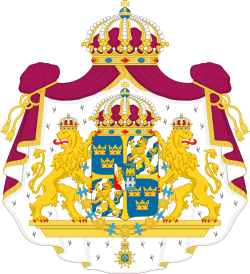Regions of Sweden
A regional council (Swedish: landsting) is a self-governing local authority and one of the principal administrative subdivisions of Sweden. There are 21 regional councils (one of which is a municipality having the same responsibilities as a county council), each corresponding to a county. County councils are governed by a regional assembly (regionfullmäktige) that is elected by the regional electorate every four years in conjunction with the general elections. The most important responsibilities of regional councils are the public health care system and public transportation.
| Public administration in Sweden |
|---|
 |
| Counties of Sweden |
|
| Municipalities of Sweden |
| List of municipalities |
| Administrative divisions |
Within the same geographical borders as the regional councils, there are county administrative boards, an administrative entity appointed by the government. As of 2010, the different regional council assemblies had a combined total of 1,696 seats.[1]
Constitutionally, the regional councils exercise a degree of municipal self-government provided by the Basic Laws of Sweden. This does not constitute any degree of federalism, which is consistent with Sweden's status as a unitary state.
Within the geographic boundaries of the county there are also several smaller municipalities and administration that exercise local self-government independent of the regional councils. These can also be referred to as "primary municipalities" or primärkommuner, while the larger regional councils are sekundärkommuner, "secondary municipalities". The Municipality of Gotland is an exception, due to its geographical boundaries, as Gotland Municipality also has the responsibilities of a regional council.
Historically, Stockholm was separate from counties and was not under the jurisdiction of the Stockholm County Council until 1967, and some other large cities were in counties but outside regional councils. The cities handled the responsibilities. The two last such cities were Malmö and Göteborg until 1998.
In January 2020, the county councils (landsting) of Sweden were officially reclassified as Regions (regioner). De facto, the regional councils had already adopted the 'Region' title well before the new law was adopted.[2][3]
| County | Regional Council | Landsting | |
|---|---|---|---|
| 1. | Blekinge | Blekinge Regional Council | Region Blekinge |
| 2. | Dalarna | Dalarna Regional Council | Region Dalarna |
| 3. | Gotland | Gotland Municipality[lower-alpha 1] | Region Gotland[lower-alpha 1] |
| 4. | Gävleborg | Gävleborg Regional Council | Region Gävleborg |
| 5. | Halland | Halland Regional Council | Region Halland |
| 6. | Jämtland | Jämtland Regional Council | Region Jämtland Härjedalen |
| 7. | Jönköping | Jönköping Regional Council | Region Jönköpings län |
| 8. | Kalmar | Kalmar Regional Council | Region Kalmar län |
| 9. | Kronoberg | Kronoberg Regional Council | Region Kronoberg |
| 10. | Norrbotten | Norrbotten Regional Council | Region Norbotten |
| 11. | Skåne | Skåne Regional Council | Region Skåne |
| 12. | Stockholm | Stockholm Regional Council | Region Stockholm |
| 13. | Södermanland | Södermanland Regional Council | Region Sörmland |
| 14. | Uppsala | Uppsala Regional Council | Region Uppsala |
| 15. | Värmland | Värmland Regional Council | Region Värmland |
| 16. | Västerbotten | Västerbotten Regional Council | Region Västerbotten |
| 17. | Västernorrland | Västernorrland Regional Council | Region Västernorrland |
| 18. | Västmanland | Västmanland Regional Council | Region Västmanland |
| 19. | Västra Götaland | Västra Götaland Regional Council | Västra Götalandsregionen |
| 20. | Örebro | Örebro Regional Council | Region Örebro län |
| 21. | Östergötland | Östergötland Regional Council | Region Östergötland |
- The Municipality of Gotland is an exception, due to its geographical boundaries, as Gotland Municipality (Region Gotland) also has the responsibilities of a regional council.
See also
- Category:County Councils of Sweden
- County administrative boards of Sweden
- Regions of Finland
References
- "Val till landstingsfullmäktige - Valda" (in Swedish). Valmyndigheten. Retrieved 2019-07-07.
- Riksdagsförvaltningen. "En ny beteckning för kommuner på regional nivå och vissa frågor om regionindelning Konstitutionsutskottets Betänkande 2019/20:KU3 - Riksdagen". riksdagen.se (in Swedish). Retrieved 2020-01-04.
- "Viktigare lagar och förordningar inför årsskiftet 2019/202" (PDF). Government of Sweden.
External links
- Municipalities and regions
- Official translation of the Local Government Act *About Stockholm County Council